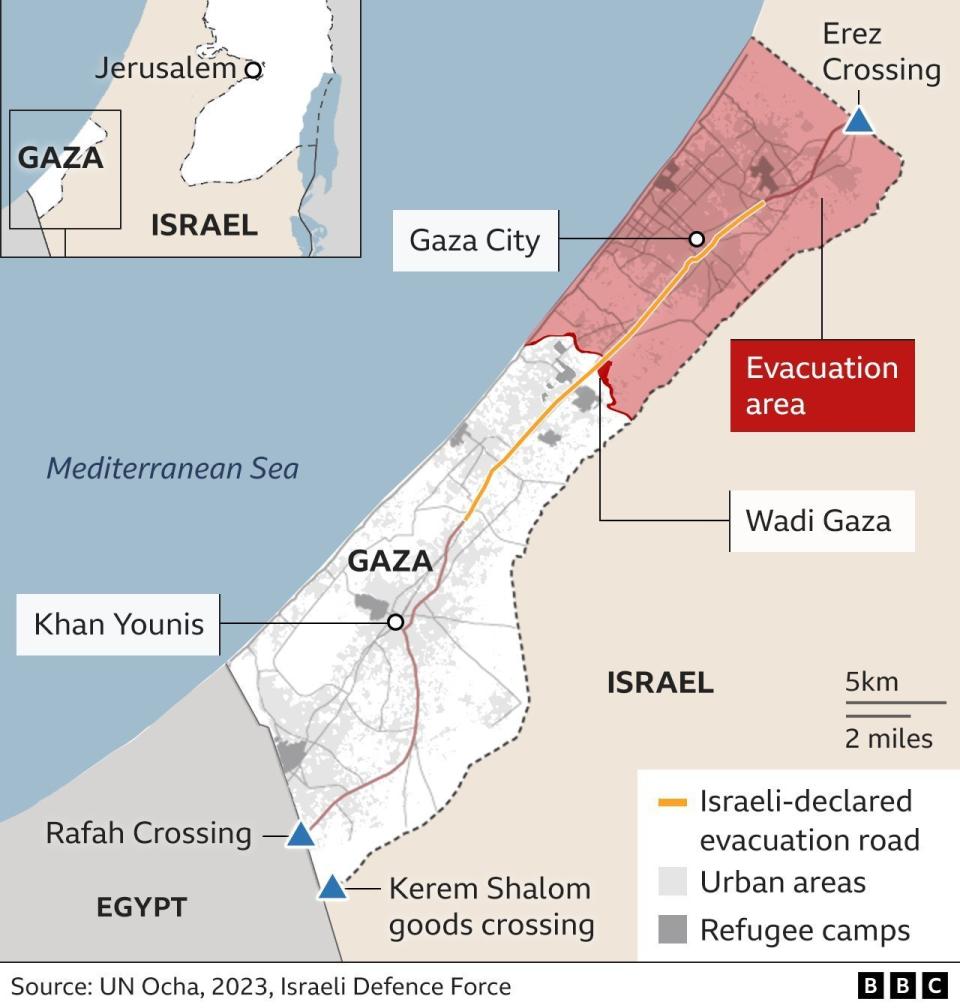The Rafah border crossing with Egypt in the southern Gaza Strip opened on Saturday to allow aid trucks to enter Gaza for the first time since the Israel-Hamas war erupted.
Israel has agreed to let 20 trucks carrying food, water, and medicine into Gaza from Egypt, but not fuel.
It is uncertain how long the border will remain open.
In recent days, Palestinians had gathered at the crossing in hopes of leaving before an expected Israeli ground offensive.
Overview of the Rafah crossing
The Rafah crossing is the southernmost exit point from Gaza and shares a border with Egypt’s Sinai peninsula.
There are only two other border crossings to and from the Gaza Strip – Erez, a crossing for individuals with Israel in northern Gaza, and Kerem Shalom, a commercial goods junction with Israel in southern Gaza. Both are closed.
Significance of the crossing now
In an unprecedented assault on southern Israel by gunmen from the Palestinian militant group Hamas, which governs Gaza, the Erez crossing was attacked on October 7, resulting in over 1,300 casualties.
In response, Israel declared the closure of Erez and Kerem Shalom until further notice, leaving Rafah as the sole entry and exit point for people in the Strip.
Rafah is now also the only crossing point for humanitarian aid.
Last week, the Egyptian foreign ministry announced that international aid flights for Gaza were directed to El-Arish airport in northern Sinai. Dozens of lorries carrying fuel and humanitarian goods are currently stationed on the Egyptian side of the Rafah crossing.
This embedded content is not available in your region.
Situation at the crossing
Hamas and Egypt have control over who can pass through, but operations have been disrupted due to Israel’s waves of air strikes on Gaza as retaliation for Hamas’s assault.
Egyptian media reported the closure of the crossing following three Israeli strikes on October 9 and 10, causing injuries on both the Egyptian and Palestinian sides of the border.
On October 12, the Egyptian government requested Israel to cease strikes near the Rafah border crossing to establish a “support lifeline” for people in Gaza. The passage will only open once the safety of its staff is guaranteed.
Western countries are also involved in securing safe passage through Rafah for foreign passport holders and humanitarian aid.
Both UK Foreign Secretary James Cleverly and US Secretary of State Antony Blinken stated their efforts to work with Israel, Egypt, and other regional political leaders to reopen the crossing.
Last week, the US Department of State advised American citizens in Gaza to head towards Rafah as the crossing may open with little notice for a limited time.
On Monday, crowds gathered at Rafah after reports of a temporary reopening during a brief ceasefire, but this was swiftly denied by both Israel and Hamas.
The crossing finally opened on Saturday, allowing 20 trucks to transport aid into Gaza from Egypt.

Reasons for the closure of the crossings
Since Hamas took control of Gaza in 2007, Israel and Egypt have imposed restrictions on the movement of goods and people in and out of the area, citing security concerns.
In response to Hamas’s attack, Israel’s defense minister ordered a “complete siege” of Gaza on October 9, resulting in the closure of all essential supplies.
Egypt, while considering reopening the Rafah crossing for foreign passport holders and humanitarian aid, is concerned about a large influx of Palestinian refugees fleeing the war.
Egypt’s president warned on October 12 that a mass exodus from Gaza could jeopardize the Palestinian cause and urged Palestinians to remain steadfast on their land.
The country is also wary of potential infiltration by Islamist militants, as it has been dealing with a jihadist insurgency in Sinai for nearly a decade.
Typical use of the Rafah crossing
Leaving Gaza through Rafah is not an easy process for Palestinians. To use the crossing, they must register with local Palestinian authorities weeks in advance and may be denied entry by either the Palestinian or Egyptian authorities without prior notice or explanation.
According to the UN, in August 2023, the Egyptian authorities allowed 19,608 exits from Gaza and denied entry to 314 people.


